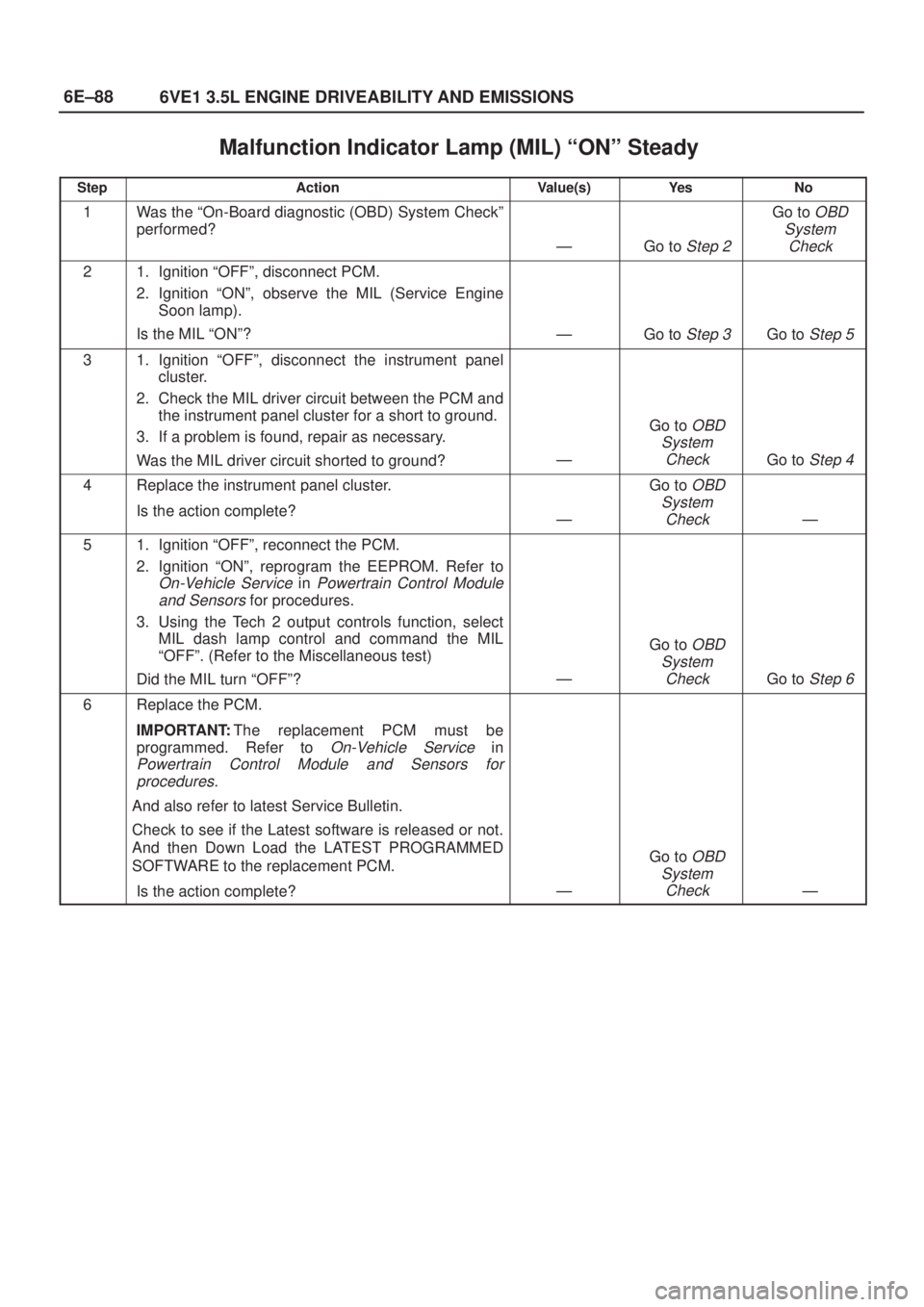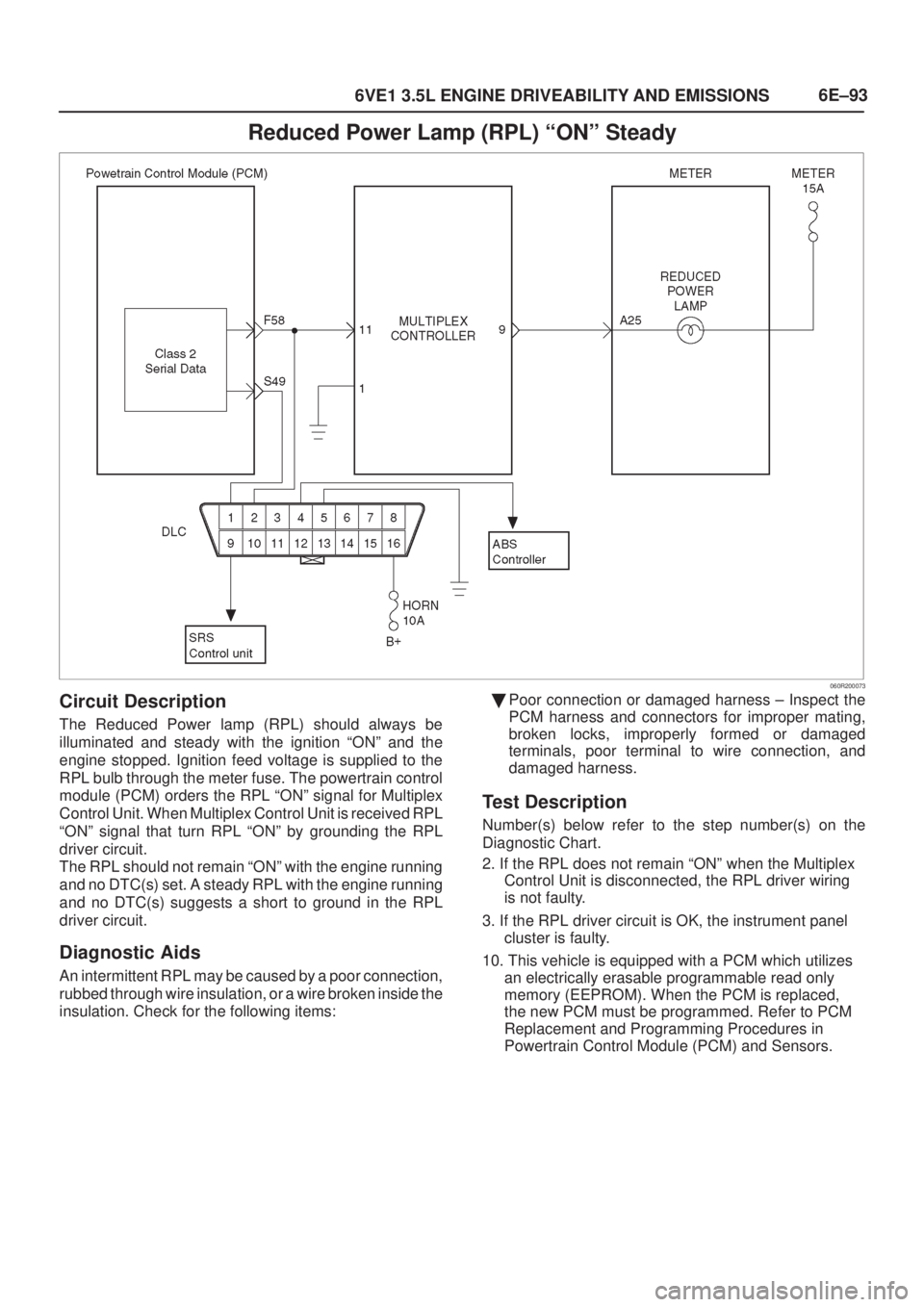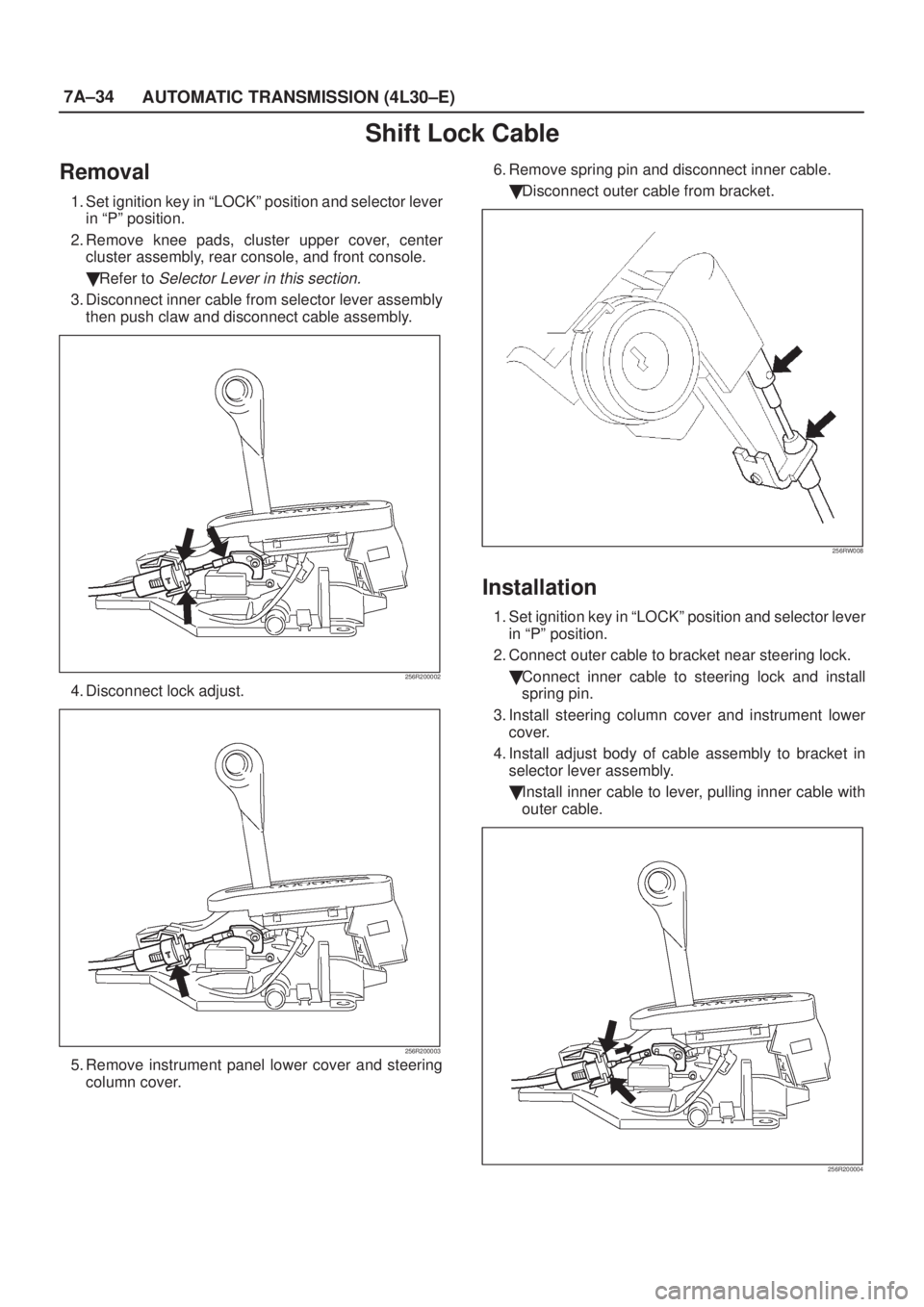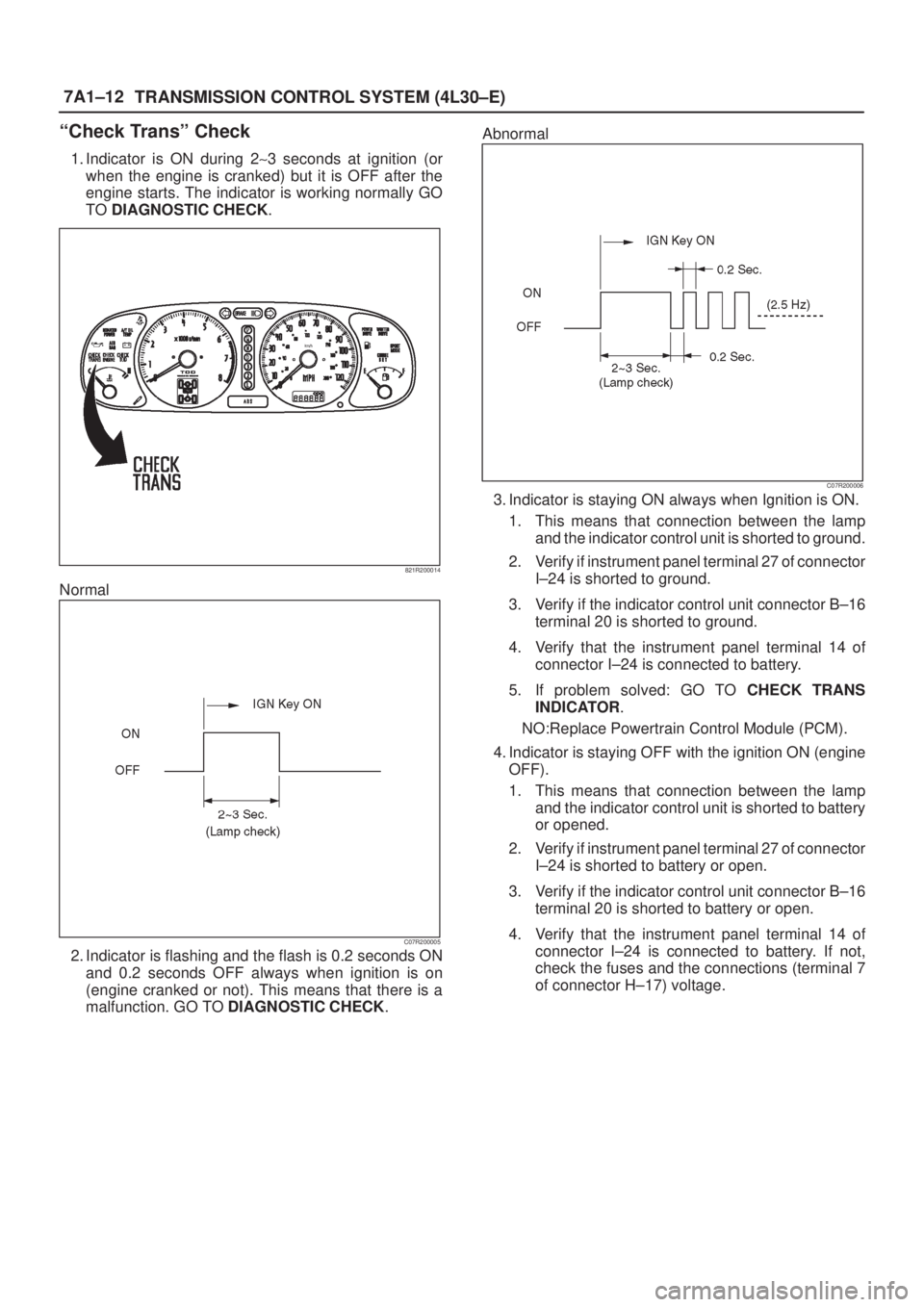Page 1055 of 2100

6E±88
6VE1 3.5L ENGINE DRIVEABILITY AND EMISSIONS
Malfunction Indicator Lamp (MIL) ªONº Steady�
StepActionValue(s)Ye sNo
1Was the ªOn-Board diagnostic (OBD) System Checkº
performed?
ÐGo to Step 2
Go to OBD
System
Check
21. Ignition ªOFFº, disconnect PCM.
2. Ignition ªONº, observe the MIL (Service Engine
Soon lamp).
Is the MIL ªONº?
ÐGo to Step 3Go to Step 5
31. Ignition ªOFFº, disconnect the instrument panel
cluster.
2. Check the MIL driver circuit between the PCM and
the instrument panel cluster for a short to ground.
3. If a problem is found, repair as necessary.
Was the MIL driver circuit shorted to ground?
Ð
Go to OBD
System
Check
Go to Step 4
4Replace the instrument panel cluster.
Is the action complete?
Ð
Go to OBD
System
Check
Ð
51. Ignition ªOFFº, reconnect the PCM.
2. Ignition ªONº, reprogram the EEPROM. Refer to
On-Vehicle Service in Powertrain Control Module
and Sensors
for procedures.
3. Using the Tech 2 output controls function, select
MIL dash lamp control and command the MIL
ªOFFº. (Refer to the Miscellaneous test)
Did the MIL turn ªOFFº?
Ð
Go to OBD
System
Check
Go to Step 6
6Replace the PCM.
IMPORTANT:The replacement PCM must be
programmed. Refer to
On-Vehicle Service in
Powertrain Control Module and Sensors for
procedures.
And also refer to latest Service Bulletin.
Check to see if the Latest software is released or not.
And then Down Load the LATEST PROGRAMMED
SOFTWARE to the replacement PCM.
Is the action complete?
Ð
Go to OBD
System
Check
Ð
Page 1057 of 2100

6E±90
6VE1 3.5L ENGINE DRIVEABILITY AND EMISSIONS
No Reduced Power Lamp (RPL)�
StepActionValue(s)Ye sNo
1Was the ªOn-Board Diagnostic (OBD) System Checkº
Performed?
ÐGo to Step 2
Go to OBD
System
Check
2Attempt to start the engine.
Does the engine start?
ÐGo to Step 3Go to Step 11
3Check the following fuses:
MAIN(100A), B+1(60A), B+2(50A), METER(15A),
ECM(15A) , ENGINE(15A)
Was a problem found?
ÐGo to Step 14Go to Step 4
41. Ignition ºOFFº.
2. Disconnect the cluster meter connector.
3. Ignition ªONº, Probe the ignition feed circuit at the
cluster connector with a test light to ground.
Is the test light ªONº?
ÐGo to Step 5Go to Step 15
51. Ignition ªOFFº.
2. Disconnect the Multiplex Control Unit.
3. Check the circuit (Lamp driver Circuit) between
PCM and Multiplex Control Unit.
Was a problem found?
ÐGo to Step 16Go to Step 6
61. Reconnect the cluster meter connector.
2. Disconnect the Multiplex Control Unit.
3. Jumper the RPL driver circuit at the Multiplex
Control Unit connector to ground.
4. Ignition ªONº.
Is the RPL ªONº?
ÐGo to Step 7
Go to
Instrument
Panel in
Electrical
Diagnosis
71. Ignition ªOFFº.
2. Probe the ignition feed circuit at the Multiplex
Control Unit connector with a test light to ground.
3. Ignition ªONº.
Is the test light ªONº?
ÐGo to Step 8Go to Step 17
81. Ignition ªOFFº.
2. Disconnect the PCM.
3. Check the circuit (Lamp driver Circuit) between
PCM and Multiplex Control Unit.
Was a problem found?
ÐGo to Step 18Go to Step 9
9Check the Multiplex Control Unit ground connection
and circuit.
Was a problem found?
ÐGo to Step 19Go to Step 10
10Check for damaged terminals at the Multiplex Control
Unit.
Was a problem found?
ÐGo to Step 20Go to Step 11
111. Ignition ªONº.
2. Probe the ignition feed circuit at the PCM harness
connector with a test light to ground.
Is the test light ªONº?
ÐGo to Step 12Go to Step 21
Page 1060 of 2100

6E±93
6VE1 3.5L ENGINE DRIVEABILITY AND EMISSIONS
Reduced Power Lamp (RPL) ªONº Steady
060R200073
Circuit Description
The Reduced Power lamp (RPL) should always be
illuminated and steady with the ignition ªONº and the
engine stopped. Ignition feed voltage is supplied to the
RPL bulb through the meter fuse. The powertrain control
module (PCM) orders the RPL ªONº signal for Multiplex
Control Unit. When Multiplex Control Unit is received RPL
ªONº signal that turn RPL ªONº by grounding the RPL
driver circuit.
The RPL should not remain ªONº with the engine running
and no DTC(s) set. A steady RPL with the engine running
and no DTC(s) suggests a short to ground in the RPL
driver circuit.
Diagnostic Aids
An intermittent RPL may be caused by a poor connection,
rubbed through wire insulation, or a wire broken inside the
insulation. Check for the following items:�Poor connection or damaged harness ± Inspect the
PCM harness and connectors for improper mating,
broken locks, improperly formed or damaged
terminals, poor terminal to wire connection, and
damaged harness.
Test Description
Number(s) below refer to the step number(s) on the
Diagnostic Chart.
2. If the RPL does not remain ªONº when the Multiplex
Control Unit is disconnected, the RPL driver wiring
is not faulty.
3. If the RPL driver circuit is OK, the instrument panel
cluster is faulty.
10. This vehicle is equipped with a PCM which utilizes
an electrically erasable programmable read only
memory (EEPROM). When the PCM is replaced,
the new PCM must be programmed. Refer to PCM
Replacement and Programming Procedures in
Powertrain Control Module (PCM) and Sensors.
Page 1061 of 2100

6E±94
6VE1 3.5L ENGINE DRIVEABILITY AND EMISSIONS
Reduced Power Lamp (RPL) ªONº Steady�
StepActionValue(s)Ye sNo
1Was the ªOn-Board Diagnostic (OBD) System Checkº
performed?
ÐGo to Step 2
Go to OBD
System
Check
21. Ignition ªOFFº, disconnect Multiplex Control Unit.
2. Ignition ªONº, observe the RPL (Reduced Power
Lamp).
Is the RPL ªONº?
ÐGo to Step 3Go to Step 4
31. Ignition ªOFFº, disconnect the instrument panel
cluster.
2. Check the RPL driver circuit between the Multiplex
Control Unit and the instrument panel cluster for a
short to ground.
3. If a problem is found, repair as necessary.
Was the RPL driver circuit shorted to ground?
ÐVerify repairGo to Step 4
41. Replace the Multiplex Control Unit.
2. Install the Tech 2
3. Ignition ªONº.
4. Using the Tech 2 output controls function, select
RPL dash lamp control and command the RPL
ªOFFº. (Refer to the Miscellaneous test)
Did the MIL turn ªOFFº?
ÐVerify repairGo to Step 5
51. Ignition ªOFFº.
2. Disconnect the PCM.
3. Check the circuit (Lamp driver Circuit) between
PCM and Multiplex Control Unit.
Was a problem found?
ÐGo to Step 6Go to Step 7
6Locate and repair the circuit between Multiplex Control
Unit and PCM open circuit.
Is the action complete?
ÐGo to Step 7Ð
71. Install the Tech 2
2. Ignition ªONº.
3. Using the Tech 2 output controls function, select
RPL dash lamp control and command the RPL
ªOFFº. (Refer to the Miscellaneous test)
Did the MIL turn ªOFFº?
Ð
Go to Verify
repair
Go to Step 8
81. Ignition ºOFFº.
2. Disconnect the PCM.
3. Check the circuit (DLC line) between PCM and
DLC.
Was a problem found?
ÐGo to Step 9Go to Step 10
Page 1618 of 2100

7A±34
AUTOMATIC TRANSMISSION (4L30±E)
Shift Lock Cable
Removal
1. Set ignition key in ªLOCKº position and selector lever
in ªPº position.
2. Remove knee pads, cluster upper cover, center
cluster assembly, rear console, and front console.
�Refer to
Selector Lever in this section.
3. Disconnect inner cable from selector lever assembly
then push claw and disconnect cable assembly.
256R200002
4. Disconnect lock adjust.
256R200003
5. Remove instrument panel lower cover and steering
column cover.6. Remove spring pin and disconnect inner cable.
�Disconnect outer cable from bracket.
256RW008
Installation
1. Set ignition key in ªLOCKº position and selector lever
in ªPº position.
2. Connect outer cable to bracket near steering lock.
�Connect inner cable to steering lock and install
spring pin.
3. Install steering column cover and instrument lower
cover.
4. Install adjust body of cable assembly to bracket in
selector lever assembly.
�Install inner cable to lever, pulling inner cable with
outer cable.
256R200004
Page 1699 of 2100

7A1±12
TRANSMISSION CONTROL SYSTEM (4L30±E)
ªCheck Transº Check
1. Indicator is ON during 2~3 seconds at ignition (or
when the engine is cranked) but it is OFF after the
engine starts. The indicator is working normally GO
TO DIAGNOSTIC CHECK.
821R200014
Normal
C07R200005
2. Indicator is flashing and the flash is 0.2 seconds ON
and 0.2 seconds OFF always when ignition is on
(engine cranked or not). This means that there is a
malfunction. GO TO DIAGNOSTIC CHECK.Abnormal
C07R200006
3. Indicator is staying ON always when Ignition is ON.
1. This means that connection between the lamp
and the indicator control unit is shorted to ground.
2. Verify if instrument panel terminal 27 of connector
I±24 is shorted to ground.
3. Verify if the indicator control unit connector B±16
terminal 20 is shorted to ground.
4. Verify that the instrument panel terminal 14 of
connector I±24 is connected to battery.
5. If problem solved: GO TO CHECK TRANS
INDICATOR.
NO:Replace Powertrain Control Module (PCM).
4. Indicator is staying OFF with the ignition ON (engine
OFF).
1. This means that connection between the lamp
and the indicator control unit is shorted to battery
or opened.
2. Verify if instrument panel terminal 27 of connector
I±24 is shorted to battery or open.
3. Verify if the indicator control unit connector B±16
terminal 20 is shorted to battery or open.
4. Verify that the instrument panel terminal 14 of
connector I±24 is connected to battery. If not,
check the fuses and the connections (terminal 7
of connector H±17) voltage.
Page 1707 of 2100

7A1±20
TRANSMISSION CONTROL SYSTEM (4L30±E)
C07RT006
Class 2 data is also pulse width modulated. Each bit of
information can have one of two lengths: long or short. On
the other hand, UART data bits come in only one length
(short). The pulse width modulation of Class 2 data allows
better utilization of the data line.
The message carried on Class 2 data streams are also
prioritized. This means that if two devices try to
communicate on the data line at the same time, only the
higher priority message will continue. The device with the
lower priority message must wait.
NOTE: The Class 2 data wire is always terminal 2 of the
new 16±terminal Data Link Connector (DLC).
16 ± Terminal Data Link Connector (DLC)
OBD II standardizes Data Link Connector (DLC)
configurations. The DLC, formerly referred to as the
ALDL, will be a 16±terminal connector found on the lower
left side of the driver's side instrument panel. All
manufacturers must conform to this 16±terminal
standard.
826R200011
Page 1790 of 2100
8A±14LIGHTING SYSTEM
Vanity Mirror Illumination Light Bulb
Removal
1. Disconnect the battery ground cable.
2. Remove the lens (1).
3. Remove the bulb (2).
805R200004
Installation
To install, follow the removal steps in the reverse order.
Switch Unit Assembly Illumination Light Bulb
(Power/Winter & Intelligent Suspension Switch)
Removal
1. Disconnect the battery ground cable.
2. Remove the center cluster assembly.
�Refer to
Instrument Panel Assembly in Body
Structure
section.
3. Remove the audio.
�Refer to
Audio in Entertainment section.
4. Remove the illumination light bulb.
825R200036
Installation
To install, follow the removal steps in the reverse order.